The Power of Practice
The NIH Clinical Center Medical Simulation Program Delivers Real-World Training
BY SEPPIDEH SAMI, NIH CLINICAL CENTER and the NIH CATALYST STAFF
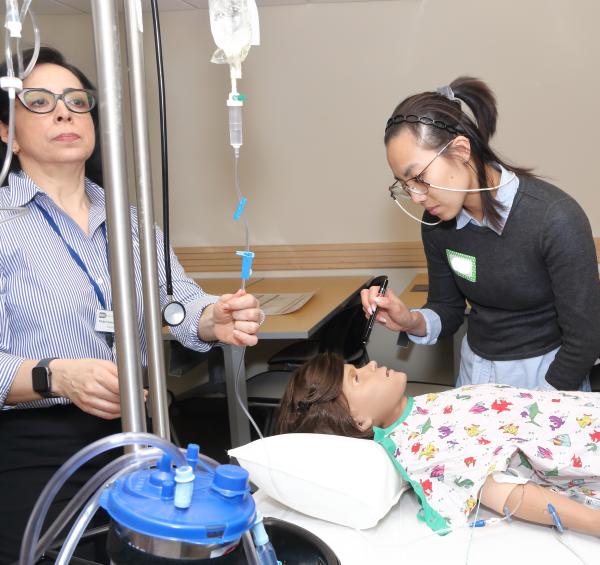
CREDIT: DONA JONES, NINR
Mabel Gómez (left), simulation facilitator and educator, monitors IV fluids during a simulation training.
Poor Scott Watkins. He seems to suffer one medical catastrophe after another. Today it was an anaphylactic event during an outpatient visit right here in the NIH Clinical Center (CC). He was exhibiting the classic symptoms: Shortness of breath, generalized rash, and gastrointestinal stress. But his treatment was—how shall we say this delicately—subpar.
The medical provider didn’t recognize the symptoms at first. Then they fumbled with the EpiPen, applying it incorrectly. Scott remained in full cyanosis with eyes partially open. Call the Code Blue team!
Fortunately for this medical provider—admittedly, a new trainee at the CC, still wet behind the ears in treating patients—Scott is not human and not even alive. Scott is a manikin, a sophisticated medical simulation tool used by the CC to teach trainees about proper medical care.
The CC has five such manikins that staff—with the help of clothing, wigs, and a touch of makeup—personify as adult and child, male and female patients. There’s 10-year-old Camille Jenkins with sepsis, 7-year-old Riley Morgan with a neurological emergency, 7-year-old Gabriel Romero with respiratory failure, 8-year-old Bianca Visconti with an adrenal crisis…collectively known as Pediatric HAL S2225. The adults, SimMan 3G and SimMan 3G Plus, take on similarly diverse personalities.
And the entire crew—including SimBaby and PediHAL S3005—is part of the NIH Clinical Center Simulation Program (internal access only), a joint program of the Office of Clinical Research Training and Medical Education and the Nursing Department’s Office of Nursing Professional Development. Since 2020, the program has been coordinated by Mabel Gómez, a medical doctor who serves as the simulation facilitator and educator.
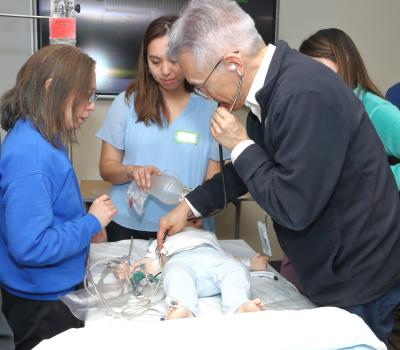
CREDIT: DONA JONES, NINR
Thomas Burklow (right), director of the simulation program, shows a group of participants how to conduct a rapid assessment on Diego Sanguinetti, a simulated pediatric patient (SimBaby) with a medical history of GM1 gangliosidosis and a cardiac arrhythmia, during the “Pediatric Bridge to Practice” course in February 2025.
Building a coordinated program
Clinical simulation has long played a role in health care education, offering a safe space to practice clinical skills, build confidence, and refine decision-making in high-pressure scenarios. The Critical Care Medicine Department began its simulation program in the 1990s under the leadership of Nitin Seam, then director of the Critical Care Fellowship. The goal was to provide interprofessional simulation exercises using clinical scenarios of rare but high-risk occurrences seen at the CC, in which critical decisions needed to be made in seconds.
In 2019, then CC CEO James Gilman envisioned an expanded simulation program. “As an institution focused on rare and especially stubborn medical issues committed to preventing lapses and error whenever possible, improving our simulation capabilities is of high importance,” as noted in the 2019 Strategic Plan, “People, Places, Capabilities: The Clinical Center at 65.”
Gilman assigned David Henderson, deputy director for clinical care (now retired); Tom Burklow, director of the CC Office of Clinical Research Training and Medical Education; and Gómez to build a strategy to advance and expand the Simulation Program. The program has steadily grown since 2020, when it started with three projects and 98 participants; by the end of 2024, it had 317 participants and 15 projects.
Gómez, having received training from the Center for Medical Simulation at Harvard Medical School, was a natural pick for the team.
“Health care simulation allows me to combine my passion for medicine and education,” she said. “I can explore and apply different simulation modalities to support our experienced clinicians in sustaining performance as well as the new trainees completing the learning curve, with the patient’s well-being as the ultimate goal.”
Ron Gillis is the program’s health care simulator technician. He had served as a simulation operations specialist at Walter Reed National Military Medical Center’s Simulation Center (Bethesda, Maryland) and as a simulation technician at Inova Fairfax Hospital in Fairfax, Virginia. He ensures that every element from scenario setup to technology management creates a realistic and immersive learning environment. “You need a blend of meticulous planning, technical expertise, and adaptability,” said Gillis.
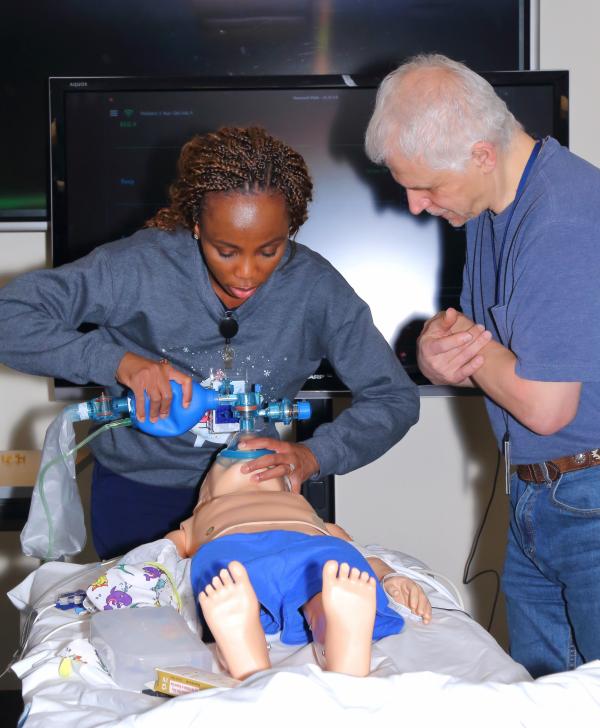
CREDIT: DONA JONES, NINR
Michael Shoykhet, a pediatric intensivist and simulation champion, guides a participant in providing adequate bag valve mask ventilation to Emma Felton, a simulated pediatric patient (PediHAL S3005) with a medical history of infantile cystinosis and respiratory failure due to anaphylaxis, during the Pediatric Bridge to Practice course in February this year.
Meet the nonhuman staff
The CC manikins are rather dynamic for lifeless creatures. Costing tens of thousands of dollars apiece, they offer realistic tactile feedback for clinical training scenarios, including injections, hands-on procedures, and emergency interventions. They look and feel like humans to the touch.
The manikins and the health scenarios they are placed in are so real that Gómez said “they don’t die”—that is, no health scenario ends in a death, because that would be too traumatic for the trainees.
The program offers four work streams designed with different objectives in mind:
- Clinical simulation: To improve and sustain performance in interprofessional and non-interprofessional teams with varying levels of training
- Translational simulation: To process improvement, system testing, and safety analysis
- Innovation: To help teams build task trainers, enhance fidelity of simulation sessions using electronic health records, and apply concepts of moulage (adding “injuries” to the manikin)
- Simulation-based research: To be the priority for the next five years
The simulation team tailors every case scenario to meet the learners’ needs and reflect the patient population and clinical practice at the CC.
The medical simulation team makes much use out of the model called Pediatric HAL S2225, an advanced child-sized medical simulator designed for realistic pediatric emergencies. It can simulate lifelike facial expressions, speech, emotional responses, and physiological reactions such as breathing, pulse, and airway obstruction. It can support training procedures such as cardiopulmonary resuscitation (CPR), intubation, IV access, trauma care, and patient interaction.
Pediatric HAL S2225 is but one machine that can take on a multitude of personalities. And its realistic responses help health care providers and students practice both technical skills and compassionate care for young patients, Gómez said.
The models SimMan 3G and SimMan 3G Plus have similar capabilities but are adult size. Both support advanced airway management, drug recognition, and real-time vital signs, and both can be equipped with female or male genitalia. The SimMan 3G Plus, the overachiever in this family, adds enhanced physical realism with modular limbs and improved joint articulation.
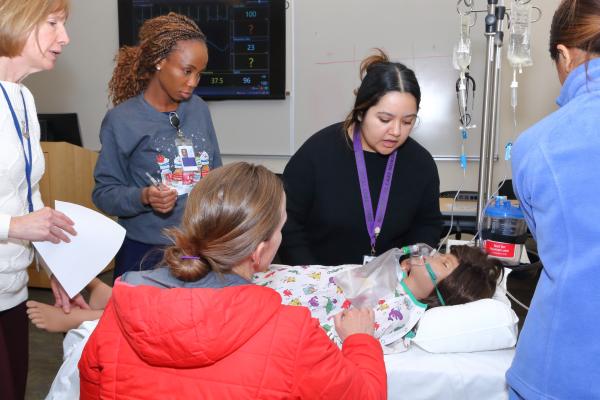
CREDIT: DONA JONES, NINR
Julie Hogan, a simulation champion, guides participants in conducting a comprehensive neuro-assessment on Diana Tobin, a simulated pediatric patient (PediHAL S2225) with a medical history of Batten disease in status epilepticus.
Broad training opportunity
As the program has grown, so has the spectrum of its learners and faculty. In addition to CC-based staff who are already licensed and credentialed, such as intensivists, bedside nurses, anesthesiologists, hospitalists, respiratory therapists, and others, the program welcomes medical students, post-baccalaureate interns, and summer interns who join an interprofessional training environment to develop new skills and to learn the importance of interprofessional communication and collaboration.
Post-simulation debriefings are the most essential part of simulation-based training, Gómez said. During the debriefings, they apply the concept of collective intelligence, where every participant is key to the program’s success. Every team member brings value to the discussion, facilitating reflections on actions to improve future performance. Through mutual respect and exchange of knowledge, productive discussions allow participants to help solve critical problems, improve processes and systems in the hospital, and improve patient care quality and safety.
Jennifer Jabara, a nurse educator, has supported the simulation program for more than six years through the use of innovative nursing education, interprofessional simulation, and evidence-based, multimodal teaching strategies. An example of such collaboration is a two-day nursing training course, “Essentials in Pediatric Nursing: Care of the Acute/Critically Ill Child,” which brings together skilled critical care nurses in adult medicine, who have no pediatric experience, with skilled pediatric nurses so that they can learn from one another.
One of the outcomes Jabara is proud of in interprofessional simulation is the meaningful debriefing sessions that follow each clinical simulation.
“When we are able to simulate high-risk, low-volume scenarios that allow providers to walk away from the debrief with new insight into the way their interprofessional colleagues think, [with] policies that drive practice, and with a reminder that we are all coming to the table to do the best we can for our patients every day—that is truly powerful,” Jabara said. “Our participants go forth in their clinical care even more prepared and confident, something our patients deserve every time they step foot inside Building 10 [where the Clinical Center is located].”
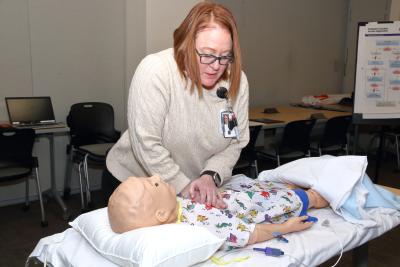
CREDIT: DONA JONES, NINR
The NIH Medical Simulation Program manikins aid in pediatric CPR training.
The simulation team has enhanced pediatric acute and critical care nursing education and training by creating four pediatric simulations, according to Patricia Todd, a pediatric clinical nurse specialist in the CC Nursing Department. This approach provides a learning experience in which learners from different nursing areas share their knowledge and experiences to gain confidence in caring for the clinically deteriorating child in a supportive and collaborative environment.
The 1-NW Pediatric Unit and the CC Simulation Program have had several successful collaborations. Helen Mayberry, program director of the Nursing Professional Practice in the NIH CC Nursing Department highlighted one such case. She said that the simulation program enhanced neuroscience nursing training for staff by integrating high-fidelity simulation with an innovative training methodology for a Neurological Clinical Decision Aid Tool.
“Since 2020, we have focused on Dr. Gilman’s vision, developing and expanding a coordinated program that serves all ICs,” said Gómez. “The next goal is to create opportunities for simulation-based research, taking advantage of being in the best place in the world to accomplish this goal.”
The NIH CC Simulation Program is available to all NIHers. The team will take the training to other Bethesda campus buildings, if invited and a Wi-Fi connection is available. If interested, access the Simulation Program website through the Clinical Center intranet, under Resources for Patient Care and Clinical Care Resources, look for the Request to Partner in Simulation link which will take you to a brief survey, and the Simulation Team will reply.
This page was last updated on Monday, May 19, 2025
